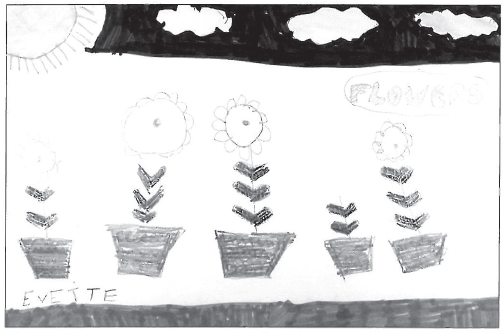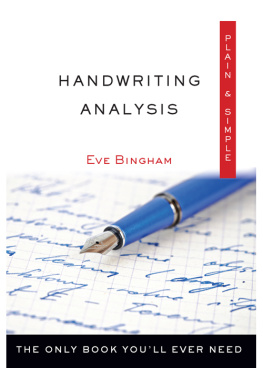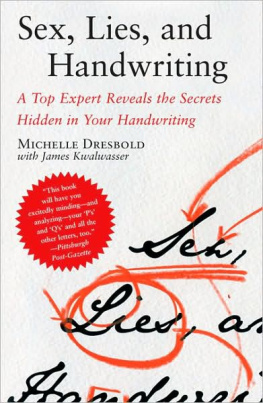Eve Bingham - Handwriting Analysis Plain & Simple
Here you can read online Eve Bingham - Handwriting Analysis Plain & Simple full text of the book (entire story) in english for free. Download pdf and epub, get meaning, cover and reviews about this ebook. publisher: Hampton Roads Publishing, genre: Home and family. Description of the work, (preface) as well as reviews are available. Best literature library LitArk.com created for fans of good reading and offers a wide selection of genres:
Romance novel
Science fiction
Adventure
Detective
Science
History
Home and family
Prose
Art
Politics
Computer
Non-fiction
Religion
Business
Children
Humor
Choose a favorite category and find really read worthwhile books. Enjoy immersion in the world of imagination, feel the emotions of the characters or learn something new for yourself, make an fascinating discovery.
- Book:Handwriting Analysis Plain & Simple
- Author:
- Publisher:Hampton Roads Publishing
- Genre:
- Rating:5 / 5
- Favourites:Add to favourites
- Your mark:
- 100
- 1
- 2
- 3
- 4
- 5
Handwriting Analysis Plain & Simple: summary, description and annotation
We offer to read an annotation, description, summary or preface (depends on what the author of the book "Handwriting Analysis Plain & Simple" wrote himself). If you haven't found the necessary information about the book — write in the comments, we will try to find it.
Handwriting Analysis Plain & Simple — read online for free the complete book (whole text) full work
Below is the text of the book, divided by pages. System saving the place of the last page read, allows you to conveniently read the book "Handwriting Analysis Plain & Simple" online for free, without having to search again every time where you left off. Put a bookmark, and you can go to the page where you finished reading at any time.
Font size:
Interval:
Bookmark:


Copyright 2019
by Eve Bingham
All rights reserved. No part of this publication may be reproduced or transmitted in any form or by any means, electronic or mechanical, including photocopying, recording, or by any information storage and retrieval system, without permission in writing from Hampton Roads Publishing Company, Inc. Reviewers may quote brief passages.
Previously published in 2007 as Simply Handwriting Analysis
by Sterling Publishing Company
Cover design by Jim Warner
Interior design by Kathryn Sky-Peck
Hampton Roads Publishing Company, Inc.
Charlottesville, VA 22906
Distributed by Red Wheel/Weiser, LLC
www.redwheelweiser.com
Sign up for our newsletter and special offers by going to www.redwheelweiser.com/newsletter/
ISBN: 978-1-57174-788-4
Library of Congress Control Number: 2018944756
Printed in the United States of America
IBI
10 9 8 7 6 5 4 3 2 1
I dedicate this book to my husband, Dave, for the culinary delights and the numerous cups of tea, and to my sister Val, for her much appreciated grammatical expertise.

W hen we were very young children, we were encouraged to draw and color pictures, but the first time we held a pencil or crayon in our hands it felt awkward and rather strange. With continued use we became more adept, but it was only when we arrived at nursery or elementary school that we were taught how to draw a picture and then sign our names at the bottom of it, usually in capital letters.
Today, our children are encouraged to develop hand-eye coordination, and most of them are able to read and write their own names by the time they reach elementary school. Writing is taught in elementary schools, with children first being taught to form letters of the alphabet, and later being taught cursive. We all have memories of the triple-lined paper we were given so we could practice staying on the line, and make sure our letter forms reached above or below the center dashed line as instructed.

A child's drawing, signed
As the years go by, a child's unique expression of writing develops. Over time, and with the encouragement of their teachers, a child's writing becomes more practiced. Most children are taught to write in a similar way, but by the time they reach the age of about twelve years, they choose to vary their writing style in accordance with their unique personalities. From that time on, their signatures become expressions of who they are.
The study of handwriting is referred to as graphology. Handwriting can also be regarded as brain writing. It is an expressive action that reveals the whole personality; each mark on the page contains meanings that a graphologist can interpret. By the time adulthood arrives, all our experiencesthe untold twists and turns, ups and downs, highs and lows of lifeare reflected in our handwriting. The overall presence of a writing sample on a plain piece of paper can denote a person's unique and individual expression of the inner self. However, while there are many traits we can identify through handwriting analysis, and many ways to identify those traits, keep in mind that it is not possible to identify the gender of an individual from a handwriting sample, or to use graphology to predict the future.
Before you begin to explore this stimulating subject, it would be helpful to collect several handwriting samples from friends and family. Just a few words positioned on a piece of paper, greeting card, or envelope will portray a lot about the writer of those words. Collect as many as possible, and with some practice you will be amazed by what can be revealed.
Different writing characteristics are called handwriting indicators or writing traits. The many script samples in this book include examples of size, slant, pressure, baseline, connection of letters and words, margins on the page and envelope, the three zones, and the signature.
Nowadays, many companies use graphology as an unbiased tool to determine a job applicant's suitability, making handwriting analysis an effective, profitable, and legal means of screening employees. To many, graphology is on par with fortune telling, but some of the largest corporations take it seriously enough to request that job applicants apply in their own handwriting.
Throughout the ages, humanity's method of communication has been primarily in the form of the written word-letters, notes, postcards, lists, reminders, and maybe even a daily diary. Nowadays, however, we rely heavily on technology-computers, cell phones, and so on-to communicate instantly with one another. This is particularly obvious among the members of the younger generation, who, it seems, rarely put pen to paper.
Our handwriting is the product of mind and body because it is composed of thoughts expressed on paper, with the physical movements controlled by the brain but using the muscles of the arm and hand. These movements are influenced by our feelingsour moods, emotions, and reactions to whatever is going on in our lives at that time. Whether we are depressed or worried, have feelings of optimism, anger, or elation, they all have a bearing on the way we write. Our innermost personality is shown on the page at the time of writing.
Whereas a person's handwriting represents the way he or she feels inside, a person's signature represents the public image that the writer wants to project. A wide variation between a person's writing and his or her signature indicates a big difference between the private and public selves. When the writing and the signature are identical, then what you see is what you get.
An ideal writing sample should be written spontaneously, in ink, on unlined paper, and should be signed by the writer. A sentence or two with a signature, or sometimes a signature alone, can be sufficient for the purposes of analysis if there are enough letters within the sample. A considerable amount of handwriting analysis is common sense. For instance, people who dot their i's and cross their t's precisely tend to be more meticulous than those who do not. Stylish people often have very stylish writing, and so on. Much of what you learn in handwriting analysis will not surprise you at all. The more you learn about graphology, the more you will learn about your friends and family.

T he size of the script is the first thing we will look at. There are basically three different sizes of scriptlarge, medium, and smallbut I have also included a discussion of very small script. Size of script expresses personal self-esteem, self-confidence, and adaptability to other people. Varying sizes within the same script indicate that the writer can be inconsistent and rather erratic.
The size of handwriting in graphology is important, for it reveals how he or she feels about and interacts with family and friends. The size of the writing is one indication of how much the writer wants to be noticed in much the same way that clothing style and color does. When we look at what people are wearing, we assume that someone wearing bold colors wants to be noticed more than someone who chooses to wear neutral tones.
Next pageFont size:
Interval:
Bookmark:
Similar books «Handwriting Analysis Plain & Simple»
Look at similar books to Handwriting Analysis Plain & Simple. We have selected literature similar in name and meaning in the hope of providing readers with more options to find new, interesting, not yet read works.
Discussion, reviews of the book Handwriting Analysis Plain & Simple and just readers' own opinions. Leave your comments, write what you think about the work, its meaning or the main characters. Specify what exactly you liked and what you didn't like, and why you think so.











